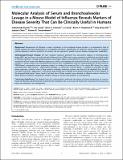Molecular Analysis of Serum and Bronchoalveolar Lavage in a Mouse Model of Influenza Reveals Markers of Disease Severity That Can Be Clinically Useful in Humans
Author(s)
Kumar, Yadunanda; Liang, Cui; Limmon, Gino V.; Liang, Li; Ooi, Eng Eong; Chen, Jianzhu; Engelward, Bevin P; Tannenbaum, Steven R; ... Show more Show less
DownloadKumar-2014-Molecular Analysis o.pdf (1.604Mb)
PUBLISHER_CC
Publisher with Creative Commons License
Creative Commons Attribution
Terms of use
Metadata
Show full item recordAbstract
Background:
Management of influenza, a major contributor to the worldwide disease burden, is complicated by lack of reliable methods for early identification of susceptible individuals. Identification of molecular markers that can augment existing diagnostic tools for prediction of severity can be expected to greatly improve disease management capabilities.
Methodology/Principal Findings:
We have analyzed cytokines, proteome flux and protein adducts in bronchoalveolar lavage (BAL) and sera from mice infected with influenza A virus (PR8 strain) using a previously established non-lethal model of influenza infection. Through detailed cytokine and protein adduct measurements of murine BAL, we first established the temporal profile of innate and adaptive responses as well as macrophage and neutrophil activities in response to influenza infection. A similar analysis was also performed with sera from a longitudinal cohort of influenza patients. We then used an iTRAQ-based, comparative serum proteome analysis to catalog the proteome flux in the murine BAL during the stages correlating with “peak viremia,” “inflammatory damage,” as well as the “recovery phase.” In addition to activation of acute phase responses, a distinct class of lung proteins including surfactant proteins was found to be depleted from the BAL coincident with their “appearance” in the serum, presumably due to leakage of the protein following loss of the integrity of the lung/epithelial barrier. Serum levels of at least two of these proteins were elevated in influenza patients during the febrile phase of infection compared to healthy controls or to the same patients at convalescence.
Conclusions/Significance:
The findings from this study provide a molecular description of disease progression in a mouse model of influenza and demonstrate its potential for translation into a novel class of markers for measurement of acute lung injury and improved case management.
Date issued
2014-02Department
Massachusetts Institute of Technology. Department of Biological Engineering; Massachusetts Institute of Technology. Department of Biology; Koch Institute for Integrative Cancer Research at MITJournal
PLoS ONE
Publisher
Public Library of Science
Citation
Kumar, Yadunanda, Cui Liang, Gino V. Limmon, Li Liang, Bevin P. Engelward, Eng Eong Ooi, Jianzhu Chen, and Steven R. Tannenbaum. “Molecular Analysis of Serum and Bronchoalveolar Lavage in a Mouse Model of Influenza Reveals Markers of Disease Severity That Can Be Clinically Useful in Humans.” Edited by Dominik Hartl. PLoS ONE 9, no. 2 (February 5, 2014): e86912.
Version: Final published version
ISSN
1932-6203